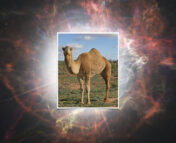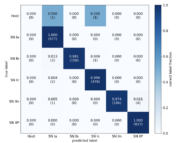Title: The Cow: Discovery of a Luminous, Hot, and Rapidly Evolving Transient
Authors: S. J. Prentice, K. Maguire, S. J. Smartt, M. R. Magee, P. Schady, S. Sim, T.-W. Chen, P. Clark, C. Colin, M. Fulton, O. McBrien, D. O`Neill, K. W. Smith, C. Ashall, K. C. Chambers, L. Denneau, H. A. Flewelling, A. Heinze, T. W.-S. Holoien, M. E. Huber, C. S. Kochanek, P. A. Mazzali, J. L. Prieto, A. Rest, B. J. Shappee, B. Stalder, K. Z. Stanek, M. D. Stritzinger, T. A. Thompson, and J. L. Tonry
First Author’s Institution: Astrophysics Research Centre, School of Mathematics and Physics, Queen’s University Belfast, United Kingdom
Status: Published in The Astrophysical Journal Letters [open access]
You’ve heard of constellations shaped like giraffes and fish, but a new finding by astronomers has added cows to the astronomical zoo! In 2018, astronomers at the Haleakalā Observatory in Hawai’i announced the detection of a unique transient event: a bright flash detected in visible wavelengths believed to be associated with a stellar explosion.
This particular event was special even among supernovae; it belongs to a unique class called Fast Blue Optical Transients (FBOTs), which are notable because of their rapid changes in brightness over time, high luminosities, and unusually hot brightness temperatures. This transient event was dozens of times brighter than the brightest supernovae, Type 1a supernovae, and if its emission was entirely thermal, it would be almost 5 times hotter than the surface of our Sun. This object presents a bit of a mystery: what exactly causes these immense explosions, and what can we learn from them?
The discovery was made with the ATLAS sky survey, which utilizes a pair of two telescopes in Hawai’i, a telescope in Chile, and one in South Africa. Their primary purpose is actually to scan the sky for asteroids on a collision course with Earth—this major scientific discovery was just an added bonus! ATLAS (the Asteroid Terrestrial-impact Last Alert System) is one of many sky surveys observing at optical wavelengths, which are ideal for detecting signatures from events like a binary black hole or neutron star collision, like those spotted with the LIGO/VIRGO gravitational wave detectors.

So, what exactly is this groundbreaking ‘cow’? The event, systematically named by the International Astronomical Union as AT2018cow, is a transient object in the sky that appeared suddenly in the Hercules constellation on June 16, 2018. Its rapid appearance and intense brightness caused it to be labeled as a superluminous supernova—a supernova 10–100 times brighter than typical supernovae. An image of the source appears in Figure 1. The location of the supernova was found to line up with the galaxy CGCG 137-068, a star-forming galaxy around 200 million light years from Earth.
Investigating the Cow’s Evolution
Using previous non-detections of the supernova by ATLAS just a few days before, the study was able to approximate the rate at which the supernova reached its peak brightness. They found that it climbed several magnitudes in optical brightness in just a few days, whereas typical supernovae take almost two weeks! The authors of this paper also tracked the evolution of the supernova over a few weeks following the initial discovery in wavelengths ranging from the infrared to the ultraviolet (shown as different colors in Figure 2). They used these data to analyze how the brightness of the supernova evolves over time and across many different frequencies. This method is called light curve analysis, and it helps astronomers distinguish many different types of supernovae from one another.

The astronomers found that while the light curve got dimmer in each band as time went on (as we’d expect from a supernova), it dimmed much faster than any model of a standard supernova predicts. Additionally, they found that the higher-energy blue bands they observed dimmed faster than the lower-energy red bands. Although the cow’s light curve looked like a typical supernova during the rise in brightness, this dimming feature is not usually seen among supernovae, and indicates that something more complex could be the source of the flash.
All of these factors have astronomers scratching their heads about the origin of this super-powered transient flash, and what possible future objects we’ll find at its source. Some of these features, like the fast climb and decay in brightness, fit well with a bright supernova creating a neutron star or black hole, but this event was significantly dimmer than the supernovae that typically create these objects. Other favored theories include the formation of a magnetar, a rapidly rotating neutron star with a high magnetic field; or, even more extreme, a white dwarf star being ripped to shreds as it passes too close to a black hole. Speculation runs rampant as of now, and astronomers are keeping their eyes and ears focused on this source to understand the cow behind this cosmic ‘mooing’!
Astrobite edited by Abigail Lee and Anthony Maue
Featured image credit: Prentice et al. 2018 and Pan-STARRS




